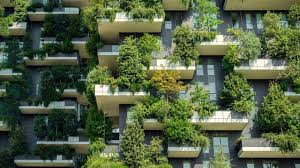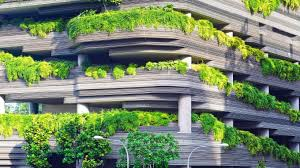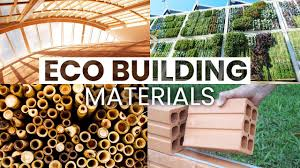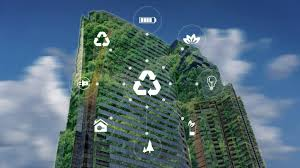Introduction:
Sustainable architecture is an approach to building design that prioritizes the environment, energy efficiency, and the use of renewable resources. This approach has gained significant attention in recent years due to the growing awareness of climate change and the need for responsible construction practices. Green building materials play a pivotal role in sustainable architecture by minimizing environmental impact and improving the quality of life for occupants. Together, they form a crucial part of the push toward a greener and more sustainable future.

How They Work:
Sustainable architecture aims to reduce the environmental footprint of buildings by using design principles and materials that are energy-efficient, resource-conserving, and environmentally friendly. Green building materials are designed with sustainability in mind, focusing on their lifecycle—from production to disposal. These materials are typically renewable, recyclable, and have a low impact on ecosystems.
Some examples of how they work include:
- Energy Efficiency: Many green building materials help buildings retain heat or cool air, reducing the need for artificial heating and cooling.
- Water Conservation: Some materials are designed to reduce water usage or capture rainwater for reuse.
- Carbon Footprint Reduction: Green materials are often produced using less energy and fewer resources, which helps reduce carbon emissions associated with their production.
- Waste Reduction: Many green materials are recycled or are designed to be reused at the end of their lifespan, minimizing waste in landfills.
What Are the Uses :
Green building materials are used in a variety of applications, from residential homes to commercial buildings. Some common uses include:
Insulation: Materials like cellulose, hemp, and recycled cotton are used to insulate buildings, providing thermal efficiency and reducing the need for artificial heating and cooling systems.
Flooring: Bamboo, cork, and reclaimed wood are popular choices for flooring as they are renewable and have minimal environmental impact.
Roofing: Green roofing materials like living roofs, solar panels, and cool roofs help improve energy efficiency by reflecting sunlight, reducing heat absorption, and providing insulation.
Walls and Foundations: Low-carbon concrete, earth-based materials (like rammed earth), and recycled bricks are commonly used for building walls and foundations.
Windows and Glazing: High-performance glass and reflective coatings help regulate temperature, reduce energy consumption, and provide better natural lighting.

Advantages:
The benefits of sustainable architecture and green building materials are numerous:
Environmental Benefits: The most significant advantage is the reduction in environmental impact. Green buildings consume less energy, produce fewer emissions, and reduce the demand for natural resources.
Energy Efficiency: Green buildings are designed to be energy-efficient, which lowers the operational costs associated with heating, cooling, and lighting. This contributes to lower utility bills for building occupants.
Improved Health and Well-being: Sustainable architecture focuses on natural lighting, ventilation, and the use of non-toxic materials, which improve indoor air quality and overall health for residents.
Cost Savings: Although the initial investment in green building materials can be higher, long-term savings from reduced energy and water consumption can offset these costs

Disadvantages:
Despite the numerous benefits, there are some challenges and disadvantages associated with sustainable architecture and green building materials:
Higher Initial Costs: The upfront cost of green building materials is often higher than traditional alternatives, which may deter some people from opting for sustainable solutions.
Limited Availability: In certain regions, eco-friendly materials may not be as readily available or affordable, making it harder for builders to source them.
Lack of Awareness: There is still a lack of widespread knowledge about the full range of sustainable materials and how they can be used effectively. This can result in some individuals or companies overlooking their potential.
Quality Control and Standardization: Some green building materials may not be as standardized as traditional ones, which can create issues in terms of consistency and quality assurance.
Future Scope:
The future of sustainable architecture and green building materials looks promising, as there is increasing global emphasis on environmental sustainability and climate change mitigation. Here are some potential developments to expect:
- Advancements in Materials: We can expect further innovation in green building materials, such as more energy-efficient insulation materials, self-healing concrete, and carbon-negative materials that absorb more carbon than they emit during production.
- Government Regulations and Incentives: As governments worldwide focus on addressing climate change, regulations and incentives will likely promote the adoption of sustainable construction practices. This could lead to more widespread use of green building materials.
- Urbanization and Smart Cities: With increasing urbanization, smart cities that integrate sustainable architecture and green materials will become more common. These cities will leverage advanced technologies to optimize energy usage and reduce the environmental footprint of urban living.
- Sustainability in the Supply Chain: In the future, building materials will likely have stricter sustainability standards throughout their entire lifecycle, from production to disposal. This will lead to the widespread adoption of circular economy principles in the construction industry.
- Integration of Renewable Energy: Buildings will increasingly incorporate renewable energy sources like solar panels, wind turbines, and geothermal energy systems, reducing their reliance on nonrenewable resources.
In conclusion, sustainable architecture and green building materials represent a vital step in the effort to reduce the environmental impact of the built environment. Although challenges remain, the long-term benefits of energy efficiency, resource conservation, and improved quality of life make this an essential part of a sustainable future. As technology and innovation continue to progress, sustainable building practices will become increasingly mainstream, playing a key role in creating a more sustainable world.


